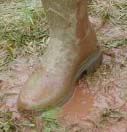|
Sustainable Food
Food Footprint: Why use the term? |
In the early 1990s, the term "Food Miles" was invented (by Tim Lang) to demonstrate the craziness of the food production and distribution system - moving similar food up and down the same motorways, shipping UK water biscuits to Australia, and flying vegetables - that could be grown at home, across the world.
In the early 2000's, the term 'carbon footprint' - borrowing the term 'footprint' from "ecological footrpint", became very popular way to get people to recognise how all their actions contribute to carbon emissions (mainly CO2 but also CH4). It is curious as 'footprint' is an area, whereas carbon dioxide is a gas - measured as a volume (eg 'carbon balloon'). More on measuring an Eco-Footprint and Carbon Counting see Towards a one planet region by ECOnw.
'Carbon footprint' has become conflated - and confused, with "food miles". The terms are often used to mean the same thing. Food miles was used as shorthand for carbon emissions. Yet there is a lot more to 'carbon emissions and more too to 'food miles'. Some people reduce the totality of environmental impacts just to just carbon emissions. eg Youngs fisheries said that moving the same Langoustines back and forth round the world was OK, as the carbon footprint is "counter intuitive". BBC Mad about Food - Sustainable Fish. This 'carbon reductionist' approach forgets the impacts of food production on water, biodiversity, fossil fuels and...land.
'Food Footprint' better represents the main environmental impact of food and farming - land. Agriculture in the world uses 80% of usable land. So 'Foot Footprint' reflects the importance of land use. As pressure on land increases, we will increasing be asking: "who is using what land and what are they doing with it?". 'Food Footprint' reminds us just whose feet we are treading on to get our food on our plate.
 Food Footprint
Food Footprint